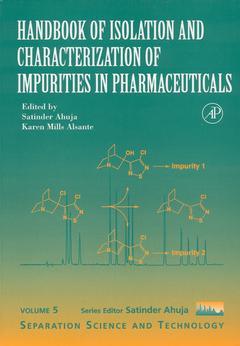Description
Handbook of Isolation and Characterization of Impurities in Pharmaceuticals
Separation Science and Technology Series
Authors: Ahuja Satinder, Alsante Karen Mills
Language: English
Publication date: 06-2003
432 p. · 18x26 cm · Hardback
Out of Print
432 p. · 18x26 cm · Hardback
Out of Print
Description
/li>Contents
/li>Readership
/li>Biography
/li>Comment
/li>
The United States Food and Drug Administration (FDA) and other regulatory bodies around the world require that impurities in drug substance and drug product levels recommended by the International Conference on Harmonisation (ICH) be isolated and characterized. Identifying process-related impurities and degradation products also helps us to understand the production of impurities and assists in defining degradation mechanisms. When this process is performed at an early stage, there is ample time to address various aspects of drug development to prevent or control the production of impurities and degradation products well before the regulatory filing and thus assure production of a high-quality drug product.This book, therefore, has been designed to meet the need for a reference text on the complex process of isolation and characterization of process-related (synthesis and formulation) impurities and degradation products to meet critical requlatory requirements.It's objective is to provide guidance on isolating and characterizing impurities of pharmaceuticals such as drug candidates, drug substances, and drug products. The book outlines impurity identification processes and will be a key resource document for impurity analysis, isolation/synthesis, and characterization.
OVERVIEW: ISOLATION AND CHARACTERIZATION OF IMPURITIES;
REVIEW OF REGULATORY GUIDANCE ON IMPURITIES; POLYMORPHIC & SOLVATOMORPHIC IMPURITIES; IMPURITIES IN DRUG PRODUCTS; STRATEGIES FOR INVESTIGATION AND CONTROL OF PROCESS AND DEGRADATION-RELATED IMPURITIES; REFERENCE STANDARDS; SAMPLE SELECTION FOR ANALYTICAL METHOD DEVELOPMENT; SAMPLE PREPARATION METHODS; ISOLATION METHODS I: THIN-LAYER CHROMATOGRAPHY; ISOLATION METHODS II: COLUMN CHROMATOGRAPHY; MASS SPECTRAL CHARACTERIZATION; NMR CHARACTERIZATION OF IMPURITES; HYPHENATED CHARACTERIZATION TECHNIQUES; SOLVING IMPURITY/DEGRADATION PROBLEMS: CASE STUDIES
REVIEW OF REGULATORY GUIDANCE ON IMPURITIES; POLYMORPHIC & SOLVATOMORPHIC IMPURITIES; IMPURITIES IN DRUG PRODUCTS; STRATEGIES FOR INVESTIGATION AND CONTROL OF PROCESS AND DEGRADATION-RELATED IMPURITIES; REFERENCE STANDARDS; SAMPLE SELECTION FOR ANALYTICAL METHOD DEVELOPMENT; SAMPLE PREPARATION METHODS; ISOLATION METHODS I: THIN-LAYER CHROMATOGRAPHY; ISOLATION METHODS II: COLUMN CHROMATOGRAPHY; MASS SPECTRAL CHARACTERIZATION; NMR CHARACTERIZATION OF IMPURITES; HYPHENATED CHARACTERIZATION TECHNIQUES; SOLVING IMPURITY/DEGRADATION PROBLEMS: CASE STUDIES
Pharmaceutical research institutes, Pharmaceutical industry, Pharmacy schools
Satinder Ahuja is a leading expert on water quality improvement. He earned his PhD in analytical chemistry from the University of the Sciences in Philadelphia. He worked for Novartis Corp. in various leadership positions for over 25 years and taught as an adjunct professor at Pace University for over 10 years. As president of Ahuja Consulting, he advises on water quality issues relating to chemicals and pharmaceuticals. A member of the executive committee of the Rivers of the World Foundation (ROW), Dr. Ahuja has organized numerous global symposia on improving water quality, including presentations for the American Chemical Society and UNESCO. Dr. Ahuja has published numerous papers and more than 25 books. His latest books are Contaminants in Our Water (ACS, 2020); Evaluating Water Quality to Prevent Future Disasters (Elsevier, 2019); Advances in Water Purification Techniques (Elsevier, 2019); and Chemistry and Water (Elsevier, 2017).
Dr. Karen Mills Alsante is a Senior Research Investigator in the Analytical Research & Development Department at Pfizer Groton Central Research. She worked as a Development Scientist in Groton Quality Operations for 3 years before moving to her current position in the Analytical Research & Development department in 1997. Over the past five years, Karen has established a Degredation Technology Group with the mission of gaining a better understanding of the chemical and physical stability of Pfizer drug substances and drug products at an earlier stage of the drug development process.
Dr. Karen Mills Alsante is a Senior Research Investigator in the Analytical Research & Development Department at Pfizer Groton Central Research. She worked as a Development Scientist in Groton Quality Operations for 3 years before moving to her current position in the Analytical Research & Development department in 1997. Over the past five years, Karen has established a Degredation Technology Group with the mission of gaining a better understanding of the chemical and physical stability of Pfizer drug substances and drug products at an earlier stage of the drug development process.
- Provides valuable information on isolation and characterization of impurities. - Gives a regulatory perspective on the subject. - Describes various considerations involved in meeting regulatory requirements. - Discusses various sources of impurities and degredation products.
© 2024 LAVOISIER S.A.S.




